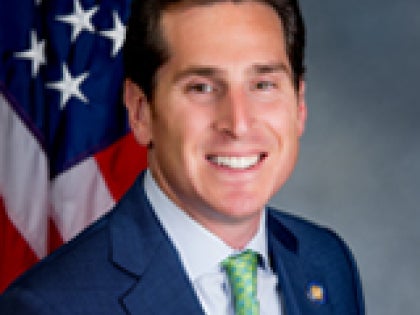
LIPA says it's working to limit customer cost of $350M storm cleanup
As LIPA works to minimize how much customers may pay of the $350 million-plus tab for Tropical Storm Isaias, state lawmakers are preparing a flurry of bills aimed at bolstering scrutiny, executive pay disclosure and the basic structure of the Long Island electric utility.
LIPA on Thursday said the tab for PSEG Long Island to restore power after Isaias could top $350 million, of which around 75%, or $260 million, could be eligible for federal reimbursement. LIPA chief Tom Falcone in an interview Friday said ratepayers wouldn't be on the hook to start repaying any unpaid balance until January, when LIPA's 2021 budget takes effect and storm costs begin to be repaid.
Although he said it was “too soon to tell” what the customer tab would be, "we are not looking to raise customer bills if we can avoid it."
But customer bills for now are taking a back seat to preparation for the remainder of storm season, and there LIPA and PSEG may have some help from lawmakers. They are preparing a range of bills aimed at increased oversight of the utility's storm restoration efforts, increased transparency of PSEG executives' individual pay packages, and measures to make sure ratepayers don't suffer the same treatment they endured after Isaias.
State Sen. Todd Kaminsky (D-Long Beach) said he was introducing a bill Friday that would force state utilities or a company under contract to a utility, such as PSEG is under LIPA, to reveal six years of executive compensation. Kaminsky said he was frustrated during Thursday’s hearing by not getting PSEG president Dan Eichhorn to reveal pay, which Eichhorn called "personal and confidential."
By contrast, the pay of all LIPA officials is publicly available.
In addition to pay disclosures, Kaminsky said he wondered if it wasn’t time to make LIPA more accountable in its oversight role of PSEG.
“I think that if LIPA’s job is to oversee PSEG and PSEG is completely failing then what is LIPA doing?” Kaminsky said Friday. “They [LIPA] have a whole team in place and yet they’re looking around like any member of the public saying, ‘What just happened?’ after a storm. But the problem is they’re supposed to provide those answers.”
Eichhorn on Friday said the structure in which PSEG operates the system under contract to LIPA was one that works. "Let's not take a structure that has worked and done tremendous good and tear it apart," he said. "We know the [Isaias] experience was not good and we're going to fix it … But let's not forget about the good things that PSEG and LIPA have done."
State Sen. Jim Gaughran (D-Northport) this week introduced a bill that begins to tackle that problem. It would give the Public Service Commission the authority to launch a probe of PSEG/LIPA if power isn’t restored on Long Island 72 hours after the governor declares a state of emergency, along with the ability to fine the utility and enact fixes.
Gaughran at a state hearing Thursday pressed LIPA about its oversight and staffing but left with inadequate answers. “At least for storms," he said, "we have to give the PSC full authority.”
Falcone, in the interview Friday, said 30 people at LIPA had oversight of PSEG, and 12 people were involved in oversight of PSEG during the tropical storm.
“We have a lot of tools in the tool kit already” to crack down on PSEG, Falcone said. “Especially on Long Island we have the best tools in the state. We can just switch the contractor.” LIPA’s contract with PSEG allows it to terminate the contract for cause, with restrictions.
Falcone argued that the current structure in which nine LIPA board members are effectively the LIPA regulators is essentially the same, if not better, as what other utilities have with the PSC as their regulator.
“It’s better to have nine people who are customers, prominent people on the Island who understand what’s going on here,” to regulate the local utility, he said. “It seems to me like a strength, not a weakness.”
Worse, he said, if LIPA were to come under full PSC scrutiny, it would have to refinance billions of dollars in debt to change bond covenants to include the new designation of the PSC as LIPA’s regulator.
“Number one, we have bonds that are outstanding that say the LIPA board will set the rates,” Falcone said. “If you want to remove that covenant you have to retire all that existing debt. It’s very expensive to refinance $5 billion of debt to change that covenant.”
In addition, Falcone said, LIPA’s contract gives it the ability to terminate its contract with PSEG for cause if the company fails to perform, which circumstance he said is preferable to the franchise agreements other utilities have with the state.
Assemb. Steve Englebright (D-Setauket) said he was so troubled by responses from the PSC chairman, LIPA and PSEG during the Thursday hearing that he was considering introducing legislation to broadly restructure LIPA.
"My belief is we should reevaluate the entire administrative structure," he said. That could include a long-standing legislative effort to allow for elected LIPA trustees rather than government appointed board members. He also wants to see more accountability and transparency, including of executive pay and LIPA's role, and an audit and oversight for the state comptroller, which the LIPA Reform Act removed.
"The governor dumbed down LIPA to make them essentially a shell, then made it very difficult for [trustees] to be advocates on behalf of the public," Englebright said. "Most of them are there to say yes to whatever comes down from the inner sanctum of the Capitol building."
State Sen. Anna Kaplan (D-North Hempstead) has introduced seven bills that would address problems related to the storm restoration, including one that would provide alternate sources of power to medically vulnerable customers, while Assemb. Jeffrey Dinowitz (D-Bronx) said he was drawing up legislation to "modernize" a utility customer bill of rights during outages.
